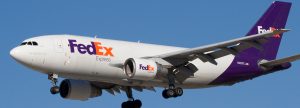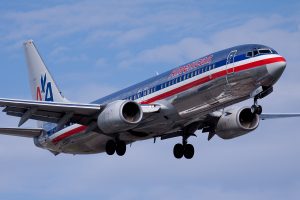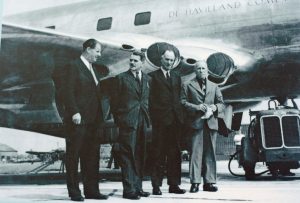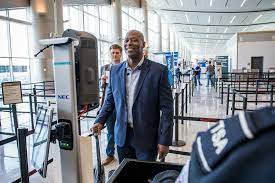9 Commercial Aircraft
Mac Jones
9.1 Introduction
Keywords
- Transportation – the action of transporting someone or something or the process of being transported
- Wright Brothers – the inventors of the idea of the airplane
- Globalization – the process by which businesses or other organizations develop international influence or start operating on an international scale
Learning Objectives
By the end of this chapter, students should be able to:
- Differentiate the forms of commercial flights and the many different things they are used for.
- Describe the past and present in the production and development of commercial flight.
- Predict possible trends or potential developments in future airplanes.
The future of aviation is fascinating. Airplanes have shown significant progress every year since the Wright brothers created them in 1903. What was once a dream in the early 1900’s, has now become a reality, with a completely strict and regulated system of commercial travel and transportation for people and goods all across the world.
The past of aviation has set us up for success. With the foundations of flight forming in 1903 with the first airplane, and the first airport in 1919, and most recently, TSA in 2001, a few months after the attacks on the Twin Towers.
The present has also been incredibly innovative. With the federal aviation administration claiming to have, “45,000 flights and 2.9 million airline passengers across more than 29 million square miles of airspace”. Our advancements in flight technology are outstanding, and more are certainly to come in the future.

“Flight Sales” by Dylan Ashe is licensed under CC BY-SA 2.0
9.2 What is commercial aviation?
Key Takeaway
There are 2 main uses for commercial flight, traveling, and shipping. Passenger flights are much more regulated, with additional security measures, dozens of different gates, flights, and concourses, passenger travel is not easy. When it comes to shipping, everything has a process and a label, making it easy to get packages and other items where they need to be.
In terms of passenger flight, commercial aircraft are a great form of long term transportation that saves lots of time and money. They can travel all over the world at speeds of hundreds of miles-per-hour. This is very time efficient considering the fact that it’s much faster than its automobile and train counterparts. Also in many cases, you cannot drive or take a train to where you want to go, this happens when traveling to islands, or across countries. This means either a boat or a plane is your only option, and due to the constantly-improving speeds of newer aircraft, your best bet is definitely flying.

“American Airline Boeing-737” by Patrick Cardinal is licensed under CC BY 2.0.
In terms of transportation of packages and other shipments, commercial aircraft are an essential part of the process. With more than a thousand shipping planes in circulation, flight has become integral in delivering packages where they need to be, while still meeting the high standards of delivery times that are promised when online shopping. Being able to ship items across the country for same-day-delivery is bewildering and very impressive. This goes to show how important these planes are to our mail and traveling businesses, especially in today’s society where convenience and speed is so important.
9.3 How did commercial aviation come to be?
Key Takeaway
Nowadays we just expect our packages to arrive on time. However, flying packages and traveling from city to city, crossing state borders, and even those of countries in transcontinental flights, takes time. Yet we have shortened this time to merely hours. According to JetBlue, a flight from Miami to Los Angeles takes only just short of 6 hours. This is an incredible feat, to cross the entire USA in less than a quarter of a day. Comparing this to the first flight shows the true progress we’ve made.
The first flight ever was commissioned by Percival Elliott Fansler, “a Florida sales representative for a manufacturer of diesel engines for boats”. He helped turn what was a 4 hour railroad trip into a 23 minute flight in an airplane. The breakthrough happened on January 1st, 1914, when pilot Tony Jannus flew the plane 21 miles from St.Petersburg to Tampa. This was the first ever commercial flight, and to see the sub-60MPH flight turn into the 500+MPH flights we have today is a testament to the incredible interest and demand we have seen in the commercial flight industry.

“First commercial jet flight” by Niall Kennedy is licensed under CC BY-NC 2.0.
9.4 Impact of Commercial Aircraft on society.
Key Takeaway
Pros:
Currently, across the world there are regulations regarding the safety of the passengers, however this is especially true in the USA. Aircrafts have to pass routine inspections and do several test flights before even coming close to the airport. Pair that with frequent and routine maintenance, and you have maybe the safest form of travel available. While yes, there is always an opportunity for an accident or a slip up, but many would argue that the risk is absolutely worth it, and that commercial aviation is a very safe way to travel.
What may be the biggest positive of commercial aviation is the convenience that it brings to millions of people globally. It allows people and families to seamlessly travel across the country, or even the world. Allowing families to connect with friends and other family members, or even to discover and experience new places is an important aspect of life and learning, and this is made possible by commercial aircraft. The timely delivery of goods from other countries or other areas of the world is made possible via the aircraft and is an important aspect of how modern society works today.

“Customer uses facial recognition as identification at TSA security checkpoint” by Delta News Hub is licensed under CC By 2.0.
Cons:
While yes, there may be a lot of outstanding benefits when referring to our commercial flight system. However, with these positives, comes a few major issues.
While it may be an option for some people and families, oftentimes flights are very expensive, especially traveling with more than 1 person. Not to mention, when traveling during busy times of the year such as holidays, the prices of flights skyrocket, sometimes tripling or even more due to the demand for tickets to visit friends and family. For families who aren’t bringing in a lot of income to the household, this can be out of reach for them.
The biggest possible problem with commercial flight is the danger aspect of it. Currently, across the world there are a lot of safety precautions, however that hasn’t always stopped dangerous things from happening in the sky. While yes, planes have to pass routine inspections, and they do have maintenance frequently. But that does not completely eliminate the possibility of issues with the plane in the air. These planes can go consecutive long flights before having a check-up. While the risk is low, it is not 0, and due to this there are possibilities of engine failure, or a multitude of other possible issues with hardware or software in the plane’s technology.
Since TSA was implemented in December of 2001, they have done a great job deterring any attacks through the air. However that does not mean that they are perfect. There is always a chance of a slip up, and due to the notoriety of the September 11th attacks, airports and the planes especially seem to be high value assets in terms of terrorist attacks. Due to this, not only is the possibility of an innocent malfunction possible, an intentional one is as well, thus making commercial aviation a possible danger to its passengers and anyone who might be affected.
9.5 The future of commercial aircraft
The future of commercial aviation is still very much up for debate, however here are some likely paths where we will likely see the next step be taken.
Space travel is an option. We see companies such as SpaceX begin to offer commercial trips to space to anyone who is interested. In fact they even say, “SpaceX also offers commercial flights to both Earth and Lunar orbit”. This is interesting, and it offers a new step in technology that no one was really expecting to come this fast, however it is unlikely that this is the closest advancements in commercial aviation due to the recency and high risk nature of the trip.

“Falcon Heavy Demo Mission” by Official SpaceX Photos is licensed under CC BY-NC 2.0.
Some may say flying cars are up next, or even affordable private aircraft, however this is very unlikely. The technology for flying cars is still decades away and is a long-shot at this point. As for the private aircraft, this is more in the realm of possibility, but it is still a reach, especially considering the fact that materials cost so much, the demand would be so high, and teaching citizens to fly and abide by the rules of the sky would be quite difficult and unrealistic.
At this moment in time the only realistic option we see in our near future is just an advancement to the basic airplanes we have in use right now. An upgrade in the materials used and the design of the aircraft would have immensely desirable effects, and allow flights to be overall better. Better technology in our aircraft would allow for a faster, more fuel efficient and ecosystem friendly flight. (A bit more comfort would go a long way too).
9.6 Chapter Summary:
At the end of the day, commercial aircraft have some clear and incredible effects on a lot of aspects in today’s society. It has allowed many people across the world to travel and experience things they otherwise wouldn’t. The convenience it has brought is immense, and has allowed for transaction and interaction between people and products across the globe. The benefits have been clear ever since the Wright brothers started this journey all the way back in 1903. Ever since then the chase for improvements has been an emphasis on the industry, and our advancements have exceeded expectations already. After the first commercial flight, commercial aviation has been slowly integrating into our society until today, where it is currently the most time and cost efficient way to travel. Due to the success of the aviator behind us, we have a successful present, and look to have a prosperous future.
Adam is a freshman student at Florida International University in Miami. To come home for Thanksgiving, it is a 5 hour drive at the minimum. This is too long for Adam, but he still really wants to come home because he is so homesick and wants to come see his family. However there is a large airport in Miami called the Miami International Airport, and so Adam can easily book a flight online and come home whenever he chooses, at a relatively low cost.
Due to the convenience provided by commercial aircraft, Adam is able to come home and spend quality time with his friends and family for a break, without the dangerous and costly 5 hour minimum drive. This is not only the case for Adam, but the case for many college students and normal citizens alike all across the country. The convenience and access provided by commercial aircraft is immensely important and beneficial to lots of people worldwide.
Review Questions
1. Who was the first person to pilot a commercial flight from St. Petersburg to Tampa?
A: Orville Wright
B: Tony Jannus
C: Percival Elliott Fansler
D: None of the above
2. How many flights does the FAA commence each year?
A: 10,650
B: 106,500
C: 16,405,000
D: 14,650
3. What is most likely the next step in commercial aviation?
A: Space travel
B: Flying cars
C: Self flying aircraft
D: Improvement in speed and comfort
4. What is the benefit of commercial aircraft?
A: Traveling experience
B: Globalization
C: Affordable and convenient trips
D: All of the above
Answers:
- B
- A
- D
- D
References:
Culick, F. E. “The Wright Brothers: First Aeronautical Engineers and Test Pilots.” AIAA Journal, vol. 41, no. 6, 2003, pp. 985–1006., https://doi.org/10.2514/2.2046.
“Secondary Navigation.” Air Traffic By The Numbers, 2 Nov. 2021, https://www.faa.gov/air_traffic/by_the_numbers/.
“Secondary Navigation.” Aircraft Safety, 10 Sept. 2021, https://www.faa.gov/aircraft/safety/.
Sharp, Tim. “World’s First Commercial Airline: The Greatest Moments in Flight.” Space.com, Space, 22 May 2018, https://www.space.com/16657-worlds-first-commercial-airline-the-greatest-moments-in-flight.html.
“TSA History.” TSA History | Transportation Security Administration, https://www.tsa.gov/history.
“Secondary Navigation.” A Brief History of the FAA, 4 Jan. 2017, https://www.faa.gov/about/history/brief_history/.
Wegener, Peter P. What Makes Airplanes Fly?: History, Science, and Applications of Aerodynamics. Springer, 1998.
The inventors of the idea of the airplane.
The action of transporting someone or something or the process of being transported.
The process by which businesses or other organizations develop international influence or start operating on an international scale.

